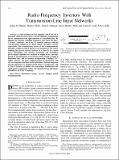Radio-Frequency Inverters With Transmission-Line Input Networks
Author(s)
Phinney, Joshua W.; Perreault, David J.; Lang, Jeffrey H.
DownloadPhinney radio-frequency.pdf (805.7Kb)
PUBLISHER_POLICY
Publisher Policy
Article is made available in accordance with the publisher's policy and may be subject to US copyright law. Please refer to the publisher's site for terms of use.
Terms of use
Metadata
Show full item recordAbstract
A soft-switching inverter topology (the Class Phi ) is presented which draws dc source current through a transmission line or a lumped-network approximation of a distributed line. By aligning the inverter switching frequency just below the line's lambda/4-wave resonance, the Class Phi topology enforces odd-and even-harmonic content in its drain voltage and input current, respectively. The symmetrizing action of the transmission-line dynamics results in natural square-wave operation of the switch, reducing the inverter stresses (relative to a Class E) for a given power throughput. The inverter waveforms and normalized power-output capability are analyzed in simple terms, and supported by measurements of an inverter built around a length of distributed line, and an inverter incorporating a lumped L-C ladder network. The latter implementation is constructed with air-core magnetics and inter-layer capacitances that are integrated into the thickness of a printed-circuit board. A comparison with a Class E inverter of similar size and ratings demonstrates the small passive-component values and manufacturing advantages afforded by the Class Phi topology.
Date issued
2007-07Department
Massachusetts Institute of Technology. Department of Electrical Engineering and Computer ScienceJournal
IEEE Transactions on Power Electronics
Publisher
Institute of Electrical and Electronics Engineers (IEEE)
Citation
Phinney, Joshua W., David J. Perreault, and Jeffrey H. Lang. “Radio-Frequency Inverters With Transmission-Line Input Networks.” IEEE Trans. Power Electron. 22, no. 4 (n.d.): 1154–1161. © 2007 IEEE
Version: Final published version
ISSN
0885-8993
1941-0107